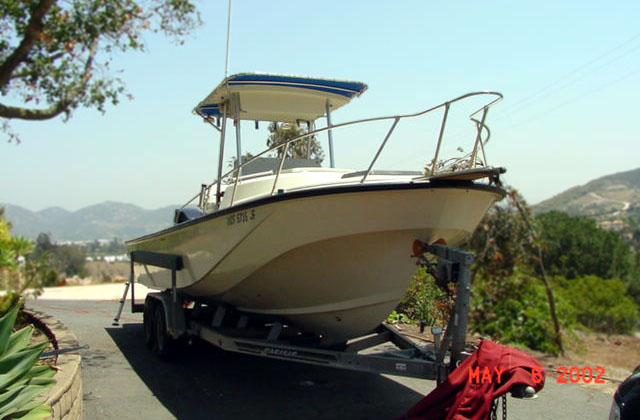
This 1987 Boston Whaler 25-Outrage Cuddy shows the classic lines of its legendary hull while resting on a PACIFC trailer. This boat has the bow pulpit option which extends the bow railing over the teak pulpit.
PhotoCredit: Fishcop - Reference: 59-01
![[Logo: WHALER CETACEA]](graphics/cetaceaLogo230x60Trans.gif)
Andy Roberts (a.k.a. Fishcop) recently bought a very unusual Boston Whaler 25-Outrage. The boat was originally delivered with a standard notched transom. The previous owner undertook a refitting to convert the boat to a full transom model with an engine setback bracket. This is a very interesting project--one that many people have thought about or talked about but few have actually done. Here's the story in Andy's own words.
"I purchased the boat in May 2002 with 100 hours on the engine. I am told the boat was purchased new in 1987. It was ordered with the cuddy option, aluminum T-top and had a standard cut transom with twin 150-HP engines. The original owner used the boat to go from San Diego to Baja and used it as a dive platform to dive on sunken wrecks in Mexican waters. The boat was sold in the mid 1990's to the second owner. He used it to fish in and around San Diego and to go camping in Baja Mexico. He had the Armstrong bracket and Optimax motor installed in 2000/2001. The local dealer in San Diego refinished the transom and accomplished the interior fiberglass design. The transom build-up was reinforced to the top, and then the bracket installed. The choice for the Optimax was made for performance and economy. (I can attest to this!)
"I trailered the boat from Southern California to its present home in the central valley (of California). It took its maiden voyage with me on May 28. Five of us left San Francisco Bay at Richmond and headed out into the Pacific Ocean. We ran about 25 miles to a place called Point Reyes to fish for salmon. We caught our limits of fish and decided to continue the voyage to some offshore islands called the Farallon's (approximately 26 miles offshore of San Francisco). Light swells and calm wind allowed a cruising speed of 30 MPH. Wide-Open-Throttle with a full load and five persons produced 41-42 MPH on both GPSs. We fished the Farallon's and caught rockfish, lingcod, and cabezon. We had a Gray Whale come within 20-feet of our boat and start "finning" or waving at us--just validates my place in the universe. We headed back home and had common dolphins escort us for several miles.
"The boat handled better than I expected and the motor was flawless. The bracket is something I have never had on personal or work boats and provides a lot of added flotation. Three of us stood on the bracket while in the water and it barely moves.
"The 225 Optimax has lots of power. I think that it is under rated at 225-HP. I have run smaller Whalers with similar carbed Mercs/Yamaha and did not get the same torque and power. The "smart gauges" I have on the boat contain a lot of information. The fuel consumption is pretty accurate for the setup I have. The troll feature is awesome! I can increase/decrease RPM's and get exactly what speed I need to troll for Tuna, Stripers, Salmon, etc. I read a lot of posts that are negative on the Optimax motors. I am sure that there is justifiable cause for this negativity, but I have just put 50 hours on my 225 and it runs better and quieter than any motor I have ever run/owned!
"As for my experience on Whalers. I grew up fishing and boating in the SF Bay area. All the fishing boats were Whalers from the 16's to the 21's (1960's and 1970's), rigged for sport and offshore commercial fishing. My first boat was a Whaler. My Chesapeake Bay Retriever (dog) is named "Montauk". I have owned classics in length from 16-feet to my present 25-feet. I love the look and ride of the Classic whaler. The wood and fiberglass reminds me of the boats I used to see when I was a child.
"I currently work in the SF and Delta area of California. My job as a "Fishcop" (on-water law enforcement) affords me the opportunity to work on several different types of boats: aluminum, fiberglass, rigid-hull-inflatibles, offshore patrol boats. My favorite boats are the classic Whalers in our fleet.
"There is a tendency in our organization to purchase the "latest" in patrol boat designs, and some of the larger Whalers are being replaced by inflatables. These boats look "stealthy" but if you check the hour meter on those boats vs. the Whalers, you will notice that the Whalers get used more often. The newer hull design has its place in our work fleet. The ride and ability to handle the heavier chop and work load is appreciated by the officers that use them. They have larger fuel cells and a wider beam than the classics. The rub rails and hardware are heavier and take the abuse well. Gray gelcoat looks too official for my taste; I prefer the older Guardians with the desert tan. We recently purchased several Optimax motors for use on rigid-hull inflatibles and a 21-foot SeaRay. The motors are great, but we had problems with the installation by the dealer. This may be the cause for the bad reputation that the motors get. If the hardware and motor is not installed correctly, the motor will not run correctly.
My choice for the classic was driven by both experience and nostalgia. The classic lines just "look right". I had a brief period when I owned a Grady White (two in fact). Very nice finish on the boat and at the dock, everybody thinks you are a millionaire! Sold them and bought another Whaler."
 |
|
Classic Whaler 25-foot Hull This 1987 Boston Whaler 25-Outrage Cuddy shows the classic lines of its legendary hull while resting on a PACIFC trailer. This boat has the bow pulpit option which extends the bow railing over the teak pulpit. PhotoCredit: Fishcop - Reference: 59-01 |
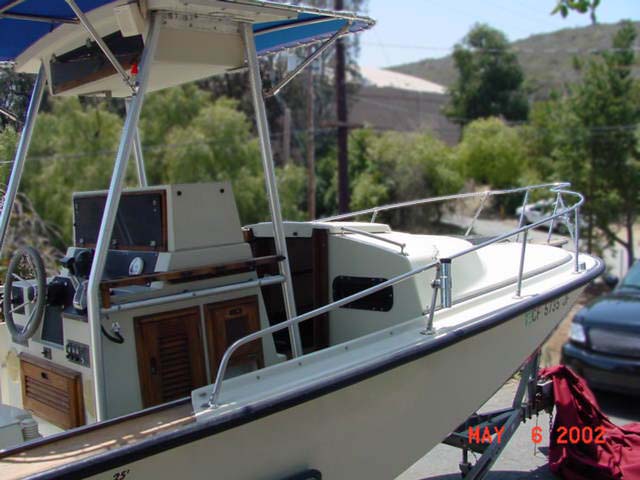 |
|
Super Console The optional larger console fills up quite a bit of the cockpit. This view shows the relationship between the console and the cuddy. Whalers from this era (late 1980's) have plenty of teak components, as seen in the console doors and trim and in the gunwales, which transition from molded to teak about midships. PhotoCredit: Fishcop - Reference: 59-02 |
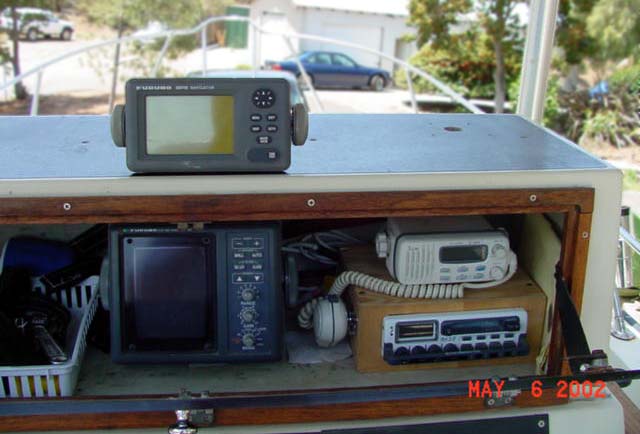 |
|
Electronics Box The big console includes a huge electronics box on top, with room for many accessories inside or mounted across the top. The tinted plexiglass cover sets into more teak trim. PhotoCredit: Fishcop - Reference: 59-03 |
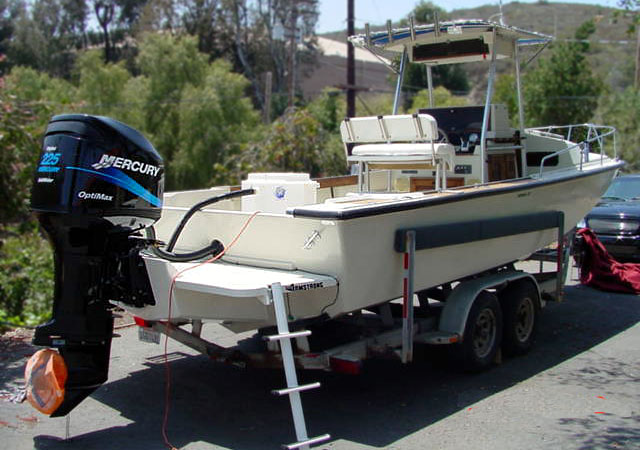 |
|
Transom Modification The stern of this classic Whaler has been converted from a standard notched outboard transom to a full transom with bracket mounted engine. The Armstrong aluminum setback bracket moves the 225-HP Mercury Optimax engine about 30-inches behind the boat. An accessory dive ladder allows easy re-entry from the water. PhotoCredit: Fishcop - Reference: 59-04 |
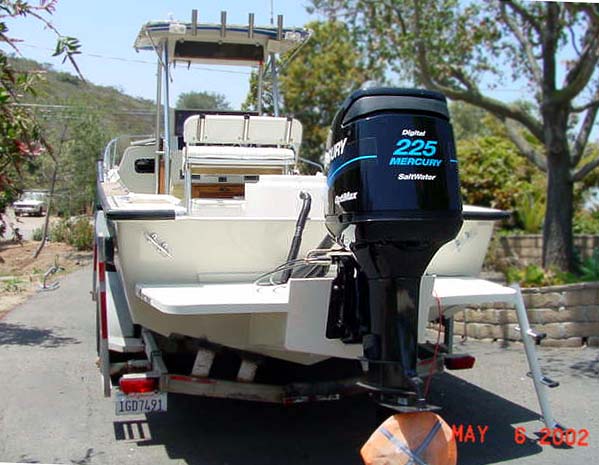 |
|
Armstrong Bracket and Digital Optimax The thickened section of the transom denotes the original standard, notched outboard transom. A "digital" outboard engine, a Mercury Optimax 225 is bolt to the bracket with mounting elevated several inches. The "digital" probably refers to the SMART-GAUGE package of instrumentation. PhotoCredit: Fishcop - Reference: 59-05 |
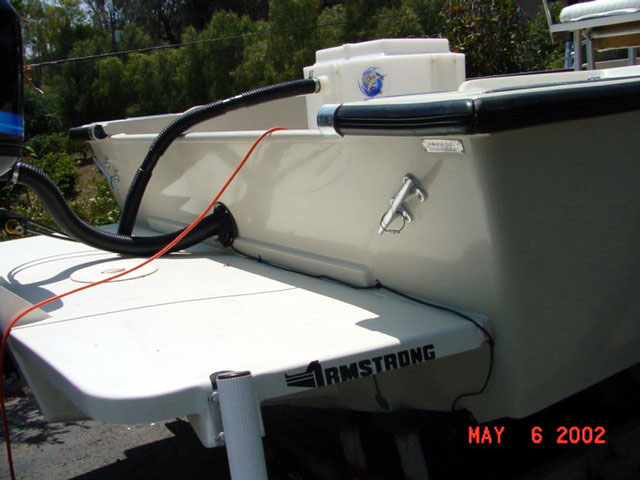 |
|
Nice Gelcoat Work This close up view shows the quality of the gelcoat work in the transom modification. PhotoCredit: Fishcop - Reference: 59-06 |
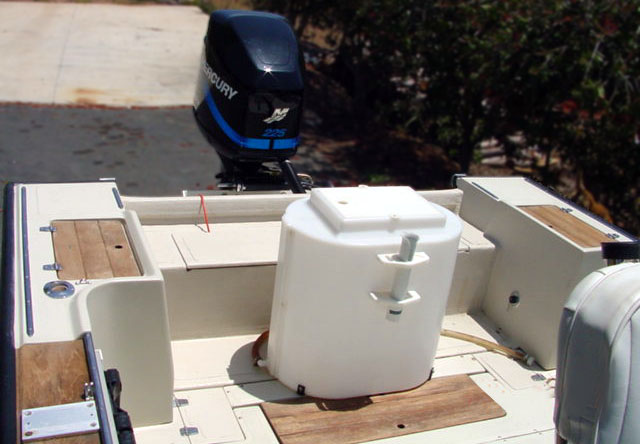 |
|
New Rear Cockpit Layout With the transom raised to full height and the engine mounted on a bracket, the entire rear cockpit of the boat changes. A new storage area has been created when the motor well used to be. The large bait tank/live well belies a strong fishing interest on the part of the previous owner. PhotoCredit: Fishcop - Reference: 59-07 |
More details of the Boston Whaler company's use of engine setback brackets on their boats is chronicled in an article on Engine Brackets in the Reference section.
continuousWave --> Whaler --> CetaceaDISCLAIMER: This information is believed to be accurate but there is no guarantee. We do our best!
The page has been accessed 45750 times.
Copyright © 2002 by James W. Hebert. Unauthorized reproduction prohibited!
This is a verified HTML 4.0 document served to you from continuousWave
URI: http://continuouswave.com/whaler/cetacea/cetaceaPage59.html
This article first appeared June 14, 2002.
Last modified: Tuesday, 19-Nov-2013 23:17:13 EST
Author: James W. Hebert